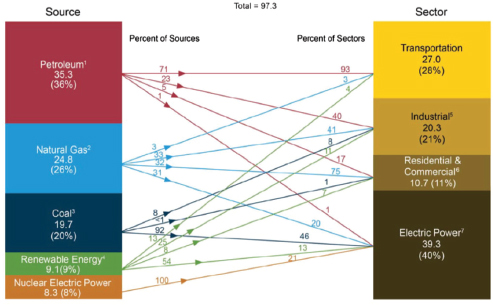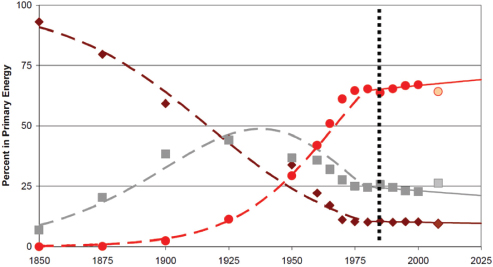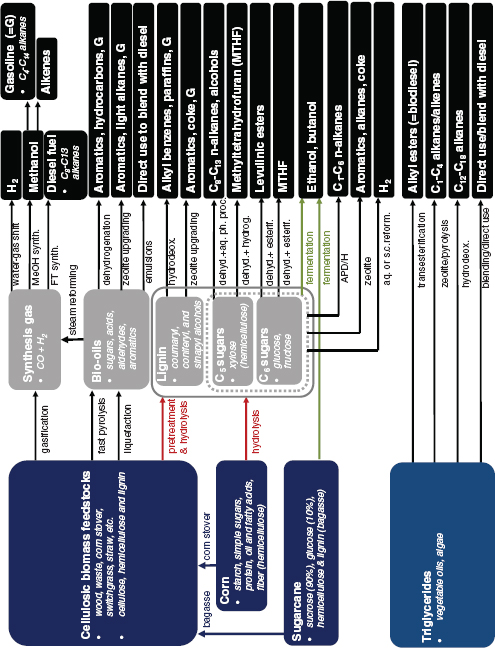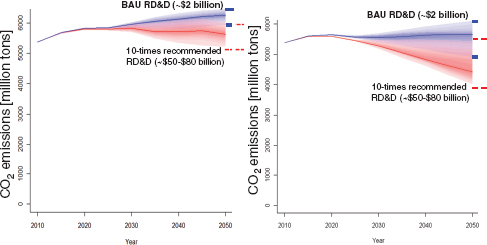Energy from Fossil Fuels: Challenges and Opportunities for Technology Innovation
LAURA DÍAZ ANADÓN
Harvard University
Energy has critical impacts on the economic, environmental, and socioeconomic dimensions of human well-being. In the United States more than 82 percent of primary energy consumed comes from fossil fuels (the total for the world is close to 80 percent), which are expected to continue to dominate given the capital intensity, longevity, and incumbent advantages of fossil-based energy systems. But neither the United States nor the world can afford to depend on an energy system that is so heavily reliant on fossil fuels. This paper presents a review of major energy challenges, the role of technology innovation, drivers of previous energy transitions, implications for research, and US policy needs to incentivize innovation.
MAJOR US ENERGY CHALLENGES IN NUMBERS
Accounting for 86 percent of total US greenhouse gas (GHG) emissions (5.7 Gt of CO2 eq. in 2011), the energy sector is the largest contributor to what is increasingly recognized as the most intractable and dangerous environmental challenge posed by human activity: global climate change.1 Most energy-related US GHG emissions stem from the use of coal for power and of oil for transportation: 38 percent of the emissions are in the form of CO2 from the power sector— three quarters come from coal—and 30 percent from the combustion of oil in the
__________________
1 In 2005 the United States contributed one-sixth of global GHG emissions (data for later years are not available) and in 2012 one-sixth of energy-related CO2 emissions. The US energy sector is also a major contributor to climate change globally, accounting for more than two-thirds of total GHG emissions in 2012.
transportation sector (EPA 2013). As shown in Figure 1, coal fuels 46 percent of the electric sector and oil 93 percent of the transportation sector.
The consequences for human well-being of GHG emissions from the fossil fuel–based US energy system are already being felt and at a faster rate than expected. A 2007 Intergovernmental Panel on Climate Change (IPCC) report states that it is more than 50 percent likely that human activities have contributed to a rise in the number of heat waves, floods, droughts, and wildfires; hurricanes and typhoons of greater power; and higher risks to coastal property from the surging seas.
Fossil fuel–based energy systems also emit substantial amounts of other pollutants such as sulphur dioxide (SO2), nitrogen oxide (NOx), and particulate matter, all of which cause significant health, ecosystem, and economic damages. A National Research Council study estimated that in 2005 energy-related US health costs were substantial: $62 billion related to the effects of coal power, $56 billion related to oil used in transportation, and $0.7 billion related to gas power (NRC 2010).
In economic terms, the fraction of US GDP devoted to oil imports has been rising, oscillating between 1.5 percent and 2.5 percent in 2005–2012, the highest level since 1983 even though crude oil imports have decreased by 16 percent since 2005 (this number is small compared to the 18 percent devoted to healthcare, but

FIGURE 1 Primary US energy consumption in 2011 by source and sector in quadrillion Btu (Quads). Total consumption = 97.3 Quads. Source: EIA 2012.
not so small compared to the 5 percent devoted to defense2). The high US dependence on foreign oil is undesirable because it exposes the country to oil supply disruptions and price shocks that could, for instance, be caused by terrorist attacks.3
THE NEED FOR AND COMPLEXITY OF ENERGY TECHNOLOGY INNOVATION
There is widespread agreement that innovation in energy-supply and end-use technologies is necessary to overcome the major energy challenges associated with US dependence on coal for power and oil for transportation.4 Partly as a result of the inherent uncertainty and complexity of the technology innovation process, there is more disagreement about the specific role of different technologies.
Innovation starts (but does not end) with discovery and invention (Narayanamurti et al. 2013)—what we engineers call research, development, and demonstration (RD&D). To have an impact, discoveries and inventions need to progress through other “stages”: demonstration, market development, and widespread deployment. Of course, technologies do not move through these stages in a linear fashion; stages often take place in parallel and there are feedbacks between them. And the pace and direction of technology innovation are shaped by a multiplicity of actors (e.g., governmental, private, not-for-profit, consumers) and institutions (e.g., norms, policies, culture).
The complexity and enormous size, ubiquity, interconnectedness, and commodity nature of most of the energy system make the transition away from fossil fuels difficult. The experience of previous energy transformations offers some insights about what may be required.
HISTORY OF ENERGY TRANSITIONS
Two main energy transitions have taken place since the Industrial Revolution. The first, starting in the late 18th century and going through the 1920s, was the emergence of steam power from coal, a development that replaced ovens,
__________________
2http://www.whitehouse.gov/administration/eop/cea/TheEconomicCaseforHealthCareReform; http://www.cfr.org/defense-budget/trends-us-military-spending/p28855.
3 On a global scale, the challenge of providing access to modern energy sources to billions of people to enable economic development is another (and perhaps even greater) challenge. An estimated 2.6 billion people around the world still rely on traditional biomass for cooking, and 1.3 billion have no access to electricity (IEA 2013). Limited access to modern sources of energy is an important contributor to poverty levels worldwide, and a major cause of the 3.5 million premature deaths per year from indoor air pollution (Lim et al. 2012).
4 In the electricity sector studies variously project more prominent roles for nuclear power, fossil power with carbon capture and storage, renewable electricity, and increased end-use efficiency. In the transportation sector, vehicle electrification, different types of biofuels, compressed natural gas, and increased efficiency could all contribute to reducing oil consumption. Some of these technologies can work as complements, others as substitutes.
boilers, furnaces, horses, and water power, and overcame the limited availability of mechanical power, low-energy densities, and the lack of ubiquitous and cheap transport systems. Stationary steam engines, which largely displaced wind and water power, were first introduced to dewater coal mines and then spread to mechanized textile manufacturing facilities and agriculture and to mobile applications in railways and ships (Grübler 2012).
The second transition was the replacement of coal steam by electricity and petroleum-based technologies, which started slowly in the late 19th century and continues today (see Figure 2). The diffusion of gasoline engines (e.g., automobiles) and electric appliances (e.g., light bulbs) was the driving force behind the second transition. It took about 100 years for steam engines and electric drives to reach 50 percent of market penetration.5
In both cases, the transition was driven not by either resource scarcity or lower prices but by niche end-use markets that were willing to pay a premium for performance based on the initial (and crucial) technology improvements. These markets reduced costs through economies of scale, standardization, and learning by doing, and provided time for complementary technologies to emerge and for parallel RD&D to further improve them.
Thus, the historical transitions suggest that a single technology cannot transform the energy system. Rather, transformations often require the formation of technology clusters (e.g., end-use technologies, distribution systems) and new applications of the original technology, both of which take time. Conversely, existing technology clusters and organizations that support the status quo create a path dependency (Arthur 1989), meaning that there is a lack of institutional (e.g., regulatory, social) and physical infrastructures needed to enable the deployment of new technologies.
Now, however, most of the technologies with the potential to significantly displace coal in the power sector and/or oil in the transportation sector are not expected to offer significant comparative advantages in terms of services provided to consumers (with the exception of some of the environmental externalities, which are still not priced in the United States). In addition, they are not expected to offer reduced costs in the short term. And niche markets (e.g., the use of biofuels or biofuel coproducts for the high-value chemicals sector, or of CO2 or other waste products as input to biofuels or other chemical synthesis) may be insufficient to drive down costs quickly enough. The commodification of energy, the path dependency of large systems, the fact that early versions of “hardware” energy technologies are usually risky and expensive, and the fact that the energy system is large, capital intensive, and long-lived all suggest that government policies to
__________________
5 Technology improves during the diffusion process. For example, it took about 100 years for steam engine efficiency to increase from 1 percent to 20 percent and almost another century to increase from 20 percent to 40 percent.

FIGURE 2 Major transitions in global energy systems measuring market shares in total primary energy use. Lines show traditional fuels such as wood, horses, water power (small diamonds), coal (squares), and modern energy sources such as oil, gas, nuclear, and modern renewables (circles). The market dynamics are approximated by a set of coupled logistic equations over the 1850–1975 period (dashed lines). The vertical dotted line denotes the end of the logistic fits and a significant stagnation of the evolution of the penetration of modern energy sources after the mid 1970s. Source: Grübler 2012. Reproduced with permission from the International Institute for Applied Systems Analysis (IIASA).
encourage experimentation, scale-up, and learning may be required over a period of decades to enable this transition.6
The sugarcane ethanol program started in 1975 in Brazil and the US shale gas program are both illustrative. Without judging whether the Brazilian government’s plan was cost effective, its continuity and comprehensiveness (addressing yields, refineries, and vehicles—end-use technologies) contributed to ethanol’s achievement of cost competitiveness with gasoline in 27 years, replacing 40 percent of all the gasoline that would be consumed in Brazil.7 It took shale gas production
__________________
6 While some policies creating markets for some of these technologies are in place today—e.g., federal production tax credits for wind, investment tax credits for solar, a renewable fuel standard for biofuels, vehicle fuel economy standards, loan guarantees for nuclear power, and renewable portfolio standards in 29 states—many studies have questioned both their cost effectiveness and their ability to serve as a guide for long-term investments by firms.
7 Ethanol from sugarcane was already produced at small scales before World War I to stabilize sugar prices and later to address oil scarcity during both World Wars, but 1975 marks the year of the start of the sustained government push to develop the sugarcane ethanol industry. A recent study estimated the direct costs of the program between 1975 and 2000 at $42.5 billion in 2013 dollars (Meyer et al. 2012), and the benefits in terms of forgone oil imports evaluated at international prices between 1975
in the United States a similar amount of time, with stable R&D funding from the Gas Research Institute (an industry-government partnership) for 24 years, a tax credit for 12 years (MIT 2011), and the persistence of a visionary entrepreneur, George Mitchell.8
IMPLICATIONS FOR RESEARCH
It is important to consider that different technology pathways pose different challenges from a commercialization perspective. For example, even though commercial biofuels are available today,9 their further expansion is not desirable because of competition with food, limited environmental benefits, and their true cost given subsidies. Alternative processes are at different stages of development and rely on different types of cellulosic biomass and algae (Figure 3 shows major biofuel production routes). However, none of these new processes is demonstrated at scale, partly as a result of high costs and the uncertainties surrounding existing regulations and physical infrastructure.
The development of biofuels that can more easily fit in with existing infrastructure (so-called drop-in fuels) should be an important factor driving research, without undermining research on alternatives that may require significant infrastructure changes but could in the long run result in significant cost reductions. Research should be underpinned by an analysis of the materials and energy involved, to focus on areas with the potential to be cost competitive in the long term. The possible impacts of different pathways are also contingent on crucial improvements in crop productivity and waste availability to reduce feedstock costs, expand the supply, and minimize other impacts, making this a particularly important research area.
POLICY NEEDS
Although there is growing government support for energy RD&D (Anadón 2012), research shows that even greater support for RD&D is needed in related
__________________
and 2002 at $64.9 billion (Goldemberg et al. 2004) (these are just the two most prominent benefits and costs).The program is also using 2.9 million hectares of land (about 29,000 km2), about the surface area of Massachusetts. The complementary end-use technology—flex-fuel vehicles capable of running on gasoline or on a blend of up to 85 percent ethanol—now dominates the automobile market, accounting for 81 percent of light-duty vehicles in 2008.
8 In the case of shale gas, changes required in the physical infrastructure and end-use technologies were less significant.
9 Biofuels in the United States and abroad are largely produced from food crops. In 2012, 211 US ethanol plants produced 13.3 billion gallons of ethanol from corn through hydrolysis and fermentation and sold it mainly as E10 (gasoline with 10 percent of ethanol in volume) to meet the requirements of the Renewable Fuel Standard. Also in 2012, 114 US biodiesel plants produced almost 1 billion gallons of biodiesel, mainly from the transesterification of soybean oil, and sold mainly as B20 (diesel with 20 percent volume of biodiesel).

FIGURE 3 Routes to making different types of biofuels from different feedstocks (slightly adapted from Huber et al. 2006 and NSF 2008). Arrows: the fermentation steps are biological conversions, the pretreatment and hydrolysis processes refer to chemical and biological processes, and the rest of the arrows represent various chemical processes. Source: Adapted from NSF, 2008. APD/H = aqueous phase dehydration/hydrogenation; aq. = aqueous; C = carbon; FT = Fischer-Tropsch; hydrodeox. = hydrodeoxygenation; MeOH = methanol; ph. proc. = phase processing; s.c. = supercritical.

FIGURE 4 US energy-related CO2 emissions 2010–2050, under business-as-usual federal energy RD&D investment with no additional demand-side policies (top band, 2050 range marked by thick lines) and 10 times the experts’ average recommended federal energy RD&D investments (between $50 and $80 billion per year) (lower band, 2050 range of emissions marked by thin discontinuous lines), with no additional demand-side policies, using (left) middle-of-the-road and (right) optimistic experts’ technology cost projections (Anadón et al., in press). Figure can be viewed in color at http://www.nap.edu/catalog.php?record_id=18558.
technology areas (Chan and Anadón, forthcoming). Research in solar power, biofuels, and utility-scale energy storage may result in the greatest returns on investment in terms of economic impact with a 2030 timeframe.10 Experience also suggests that such RD&D needs a stable, long-term, and diverse set of research institutions working in close collaboration with industry (Anadón et al., forthcoming).
Yet even if the US government increased its federal RD&D investments in a wide range of technologies from about $2 billion a year to $80 billion a year between 2010 and 2030, CO2 emissions from the energy sector are likely to remain far from the targets set by the IPCC (about 1–2 Gt/year) (Figure 4) (Anadón et al. forthcoming). Additional demand-side policies are very likely to be necessary to catalyze the transition from a modeling and historical perspective. A sufficiently high price on carbon (either through a tax or a cap-and-trade arrangement) is likely to result in the most efficient outcome, particularly because
__________________
10 Anadón et al. (forthcoming) covered 25 technologies spanning solar photovoltaics, nuclear, bioenergy, carbon capture and storage, various vehicle technologies, and utility-scale energy storage and focused on incorporating uncertainty surrounding technical change.
there is uncertainty about the options that will be most successful (Anadón et al., forthcoming).11
REFERENCES
Anadón LD. 2012. Missions-oriented RD&D institutions in energy: A comparative analysis of China, the United Kingdom, and the United States. Research Policy 41(10):1742–1756.
Anadón LD, Bunn M, Narayanamurti V. In press. Transforming US Energy Innovation. Cambridge: Cambridge University Press. The November 2011 report forming the basis of this book is available at http://belfercenter.ksg.harvard.edu/publication/21528/.
Arthur BW. 1989. Competing technologies, increasing returns and lock-in by historical events. Economic Journal 99(294):116–131.
Chan G, Anadón LD. Forthcoming. Utilizing expert assessment to inform allocating government energy RD&D investment portfolios.
EIA (US Energy Information Administration). 2012. Annual Energy Review 2011. Washington DC: Department of Energy. Available at www.eia.gov/totalenergy/data/annual/pdf/aer.pdf.
EPA (US Environmental Protection Agency). 2013. Inventory of US Greenhouse Gas Emissions and Sinks: 1990–2011. EPA 430-R-13-001. Washington DC. Available at www.epa.gov/climatechange/Downloads/ghgemissions/US-GHG-Inventory-2013-Main-Text.pdf.
Goldemberg J, Teizeira Coelho S, Nastari PN, Lucon O. 2004. Ethanol learning curve: The Brazilian experience. Biomass and Bioenergy 26:301–304.
Grübler A. 2012. Grand Designs: Historical Patterns and Future Scenarios of Energy Technological Change. In: The Global Energy Assessment: Toward a Sustainable Future, Chapter 24: Policies for the Energy Technology Innovation System—Historical Case Studies of Energy Technology Innovation. Cambridge: Cambridge University Press and International Institute for Applied Systems Analysis.
Huber GW, Iborra S, Corma A. 2006. Synthesis of transportation fuels from biomass: Chemistry, catalysts, and engineering. Chemical Reviews 106:4044–4098.
IEA. 2013. World Energy Outlook. International Energy Agency, Organization for Economic Cooperation and Development. Paris, France.
IPCC (Intergovernmental Panel on Climate Change). 2007. Climate Change 2007: Impacts, Adaptation and Vulnerability. Contribution of Working Group II to the Fourth Assessment Report of the IPCC. Cambridge: Cambridge University Press.
Lim S.S., Vos T., Flaxman AD, Danaei G, et al. 2012. A comparative risk assessment of burden of disease and injury attributable to 67 risk factors and risk factor clusters in 21 regions, 1990–2010: A systematic analysis for the Global Burden of Disease Study 2010. The Lancet. 380(9859):2224–2260.
Meyer D, Mytelka L, Press R, Dall’ Oglio EL, de Sousa PT Jr, Grübler A. 2012. Brazilian Ethanol: Unpacking a Success Story of Energy Technology Innovation. In: The Global Energy Assessment: Toward a Sustainable Future, Chapter 24: Policies for the Energy Technology Innovation System—Historical Case Studies of Energy Technology Innovation. Cambridge: Cambridge University Press and International Institute for Applied Systems Analysis.
MIT (Massachusetts Institute of Technology). 2011. The Future of Natural Gas, Appendix 8A: Natural Gas RD&D Background. The MIT Energy Initiative. Available at http://mitei.mit.edu/system/files/NaturalGas_Appendix8A.pdf.
__________________
11 The aggressiveness and existence of waivers in the Renewable Fuel Standard reduce its ability to promote innovation and fail to encourage fuel efficiency, which can be achieved by fuel or carbon taxes.
Narayanamurti V, Odumosu T, Vinsel L. 2013. RIP: The basic/applied research dichotomy. Issues in Science and Technology XXIX.2 (Winter).
NRC (National Research Council). 2010. Hidden Costs of Energy: Unpriced Consequences of Energy Production and Use. Washington DC: National Academies Press. Available at www.nap.edu/catalog.php?record_id=12794.
NSF (National Science Foundation). 2008. Breaking the Chemical and Engineering Barriers to Lignocellulosic Biofuels: Next Generation Hydrocarbon Biorefineries. Ed. George W. Huber, University of Massachusetts Amherst. National Science Foundation. Chemical, Bioengineering, Environmental, and Transport Systems Division. Washington DC. Available at www.ecs.umass.edu/biofuels/Images/Roadmap2-08.pdf.










